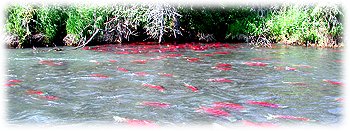

by Brad Hanson
| www.AlaskaFlyfishingOnline.com | ||
|
|

|

|
|
by Brad Hanson |
||
|
Helpful Area Fishing Maps Kenai Peninsula
The Real Deal right from the stream! CLICK HERE TO |
Years ago, before coming to Alaska, I occasionally fished egg imitations using the standard pattern... the glo-bug. It's a good pattern that still catches fish, but because flyfishers are the inquisitive type, we're always looking for something that works a little bit better than "the standard patterns."
Eggs are a big deal to fish in Alaska; in fact, salmon eggs are one of the most important foods to rainbows, char, grayling and others. Over the years, I've experimented with many variations of the egg, and this most recent pattern has some credible advantages....namely, a realistic appearance. Most flyfishers know, the aquatic insects we find in rivers and lakes, present in various stages of metamorphic development (like a caterpillar to butterfly). Depending on the timing of their life cycle, metamorphic variations dictate that anglers use imitations of the nymph, pupae, and larval or adult forms to mimic what fish are eating at the time. And, although eggs don't go through a true metamorphosis, their appearance changes enough over time, that one pattern won't always mirror the natural.
A friend, and local guide Shane Schwark, introduced me to the clay egg a few years ago on a steelhead trip. I used the interesting pattern the next day and landed a few fish, but it wasn't until later that fall that I better realized its value. Rainbows were keying on eggs, taking them with abandon, and almost any egg pattern was working. At the time, I thought the timing must be just right for that fly on that day. Well, the timing must have been right for the rest of the season, as it consistently outproduced other popular patterns, and I liked the way it fished. A clay egg has just the right density and weight to get down quickly, but it's not so heavy that it's constantly hanging on the bottom. It just fishes well, which I think is part of its effectiveness. On the downside, the earthen egg is not as durable as a plastic bead. It will occasionally crack if you whack it on a rock, but when you'll most often break it is while seating the toothpick. On the upside, you can easily choose the exact size and color variation when forming the eggs at home, and with a small investment in clay, the average flyfisher will have more than enough eggs for an entire season.
|